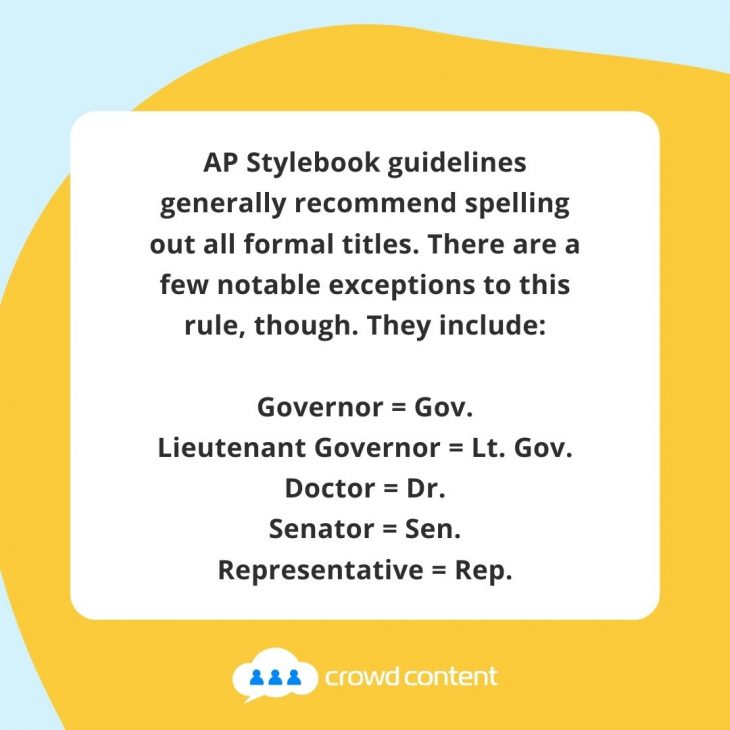Learning to write is a lot like learning to drive. You have to internalize many rules, some of which seem arbitrary or hard to remember. Formal titles, for example, are like left turns at large intersections: they’re tricky, but you need to get them right or you risk embarrassment. If you accidentally leave a formal title lowercase, you might offend someone. If you capitalize an occupational title by mistake, you end up looking like a novice.
Bewildering? At first, sure — but prep and practice makes perfect. Let’s dive into what the Associated Press (AP) Stylebook has to say about formal titles.
ALSO – Find Great Freelance Writing Jobs
Occupational Titles vs. Formal Titles: What’s the Difference?
Capitalization has absolutely nothing to do with the importance of someone’s job. Astronauts, dentists, farmers and athletes all make vital contributions to society, but you don’t capitalize occupational descriptions because they’re not formal titles.
Here are some examples:
- Legendary athlete Jesse Owens won four gold medals at the 1936 Olympic games.
- Russian astronaut Valentina Tereshkova flew a solo space mission in 1963.
- Erstwhile dentist Doc Holliday first met Wyatt Earp in 1878.

So, what are formal titles? Simply put, they’re titles given to specific people with formal authority. Government officials, people in the military, royal family members and religious leaders all have formal titles. So do doctors, lawyers and certain other academic professionals.
Interestingly, the AP Stylebook doesn’t recognize professor as a formal title. It does, however, define Professor Emeritus as a formal title. Go figure.
Here’s an example:
- Archeology professor Indiana Jones had a phobia of snakes.
If you get stuck on whether to capitalize, refer to a title’s issuing authority (also known as its conferring institution).
Always Capitalize Formal Titles Before Names
When a formal title comes directly before someone’s name, always capitalize it, like these examples:
- Chancellor Angela Merkel’s favorite foods include Hungarian vegetable stew.
- President Emmanuel Macron is the youngest French head of state since Napoleon.
- Vice President Dan Quayle met journalist Sam Donaldson for an interview.
If the formal title stands by itself, or if commas separate the title and the titleholder, capitalization isn’t necessary as these examples show:
- The current Italian president, Sergio Mattarella, was born in Palermo in 1941.
- The general walked quickly away from the gathering crowd.
You can use the same formal title rules for people who don’t permanently hold positions of authority — but don’t capitalize any adjectives that describe the formal title’s status.
Here are some examples:
- Bolivian cocalero activist and former President Evo Morales left office in November 2019.
- A former presidential hopeful, retired Gen. Wesley Clark now sits on the Atlantic Council’s board of directors.
Formal Titles and Commas
If you’re still not sure if you should capitalize someone’s title, a comma (or commas) can save your bacon. Simply use a comma sentence construction and separate the person from their title, like these examples:
- Paul Greenwood, principal of Lakeside Elementary, still hadn’t answered Jane’s email.
- The accident happened when Sheila Gibson, biology professor at Kirk College, spun out of control.
If you need to write about a person with a unique title, put a comma after the individual’s name and begin the title with “the,” like these examples:
- Marie Nelson, the marketing coach, made history on Tuesday.
- Forty-five-year-old Gerard Wilson, the deputy sheriff of Pearlview, began to speak.
Occasionally, you’ll probably have to deal with an extra-long and convoluted title. Commas make rambling monikers easier to read. For example:
- Henry Rogers, acting head of general services and recruitment, made his views clear.
- Slurring his words, Chuck Penderghast, interim vice president of ecommerce marketing, took to the podium.
When to Abbreviate Formal Titles
AP Stylebook guidelines generally recommend spelling out all formal titles. There are a few notable exceptions to this rule, though. They include:
- Governor becomes Gov.
- Lieutenant Governor becomes Lt. Gov.
- Doctor becomes Dr.
- Senator becomes Sen.
- Representative becomes Rep.

Military AP style titles follow similar rules, like this:
- Major becomes Maj.
- Captain becomes Capt.
- First Lieutenant becomes 1st Lt.
- Second Lieutenant becomes 2nd lt.
- General becomes Gen.
- Lieutenant General becomes Lt. Gen.
- Major General becomes Maj. Gen.
- Brigadier General becomes Brig. Gen.
- Colonel becomes Col.
- Lieutenant Colonel becomes Lt. Col.
The second time you refer to the titled person (and going forward), refer to the individual by their last name only.
Interestingly, rules vary for enlisted military personnel. Sergeant Major of the Army, for example, gets abbreviated to Sgt. maj. of the Army. Conversely, Master Chief Petty Officer of the Navy doesn’t get abbreviated. If you get in a muddle, check out the AP Stylebook Military Titles section.
Title-Related Things to Remember
AP rules on things like the inclusion of “U.S.” in advance of a title vary depending on where you intend to publish your story. If you’re running your article in America, you can safely leave U.S. off the beginning of a formal title — unless it causes confusion. One example might be this:
- U.S. President Obama spoke to Ford Motor Company President Mark Fields on the phone.
If you plan to run your editorial in Europe, make sure you do attach U.S., like this example:
- U.S. Vice President Mike Pence attended a formal dinner on Saturday evening.
Lastly, noble titles sometimes quite often get used without any other accompanying names. Here’s an example:
- The Duke and Duchess of Sussex had lunch with Queen Elizabeth last Monday.
Why Understanding AP Style Titles Is Important
Style guides are important because they help keep a brand’s content consistent no matter how much they produce. And, it guides all their writers to format their content consistently.
Any organization that wants to scale their content creation needs to follow a style guide.
And, the AP Stylebook is the de facto standard among digital marketers. Even if clients don’t specify they want you to follow AP Style, they probably expect you will.

Other Style Guides
It’s important to note that the rules we’ve outlined here apply only to AP Style. Be sure to review the rules for the style guide you need to follow for each assignment.
Other common style guides include:
- Modern Language Association (MLA) – mostly used in academic writing, occasionally clients may opt to use this in their orders.
- Chicago Manual of Style – another style guide mostly focused on academic writing. Similarly, it may come up in client requests from time to time.
- The Elements of Style – designed to complement the AP Stylebook, this is a condensed guide that is helpful for beginners or quick reference.
- The New York Times Manual of Style and Usage – as its name implies, this is a guide published by The New York Times. It’s widely used amongst journalists and clients looking for journalistic style content may reference it.
- The BuzzFeed Style Guide – a more recent entry to this list. This guide is geared towards sites and publishers mostly focused on publishing content on the internet and social media. This is a completely free style guide, whereas others need to be purchased.
Keep in mind that most clients will default to using AP Style, but you might see some of these other guides occasionally.
Some clients also build their own internal style guides, especially if they produce large volumes of content. Often these will refer to a major guide (like AP) but highlight unique differences they want followed.
The Wrap – Why AP Style Titles Are Important
If you don’t write formal titles properly in AP style, no decent publisher will take you seriously. Don’t let that freak you out, though — the capitalization rules aren’t hard to learn. If you’re unsure about a title, consult the AP Stylebook for advice, and if you’re still unsure, use commas to separate a person from their title. With a little practice, you’ll soon be a formal title expert.




